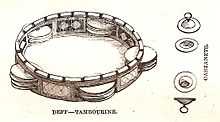Timbrel

Timbrel or tabret (the tof of the ancient Hebrews, the deff of Islam, the adufe of the Moors of Spain), the principal musical instrument of percussion of the Israelites, similar to the modern tambourine.[1]
History
The word timbrel is used in the Old Testament in both singular and plural form, so as to suggest the former referred to a hoop of wood or metal over which was stretched a parchment head; while the latter was perhaps used to designate the tambourine with bells or jangles fixed at intervals in hoops. In Nahum 2:7, where the word "tabering" occurs, it means beating on the breast, as drummers beat on the tabret. The Israelites learned to use the timbrel during their sojourn in Egypt, and in the eleventh edition of the Encyclopædia Britannica Kathleen Schlesinger stated "it has been suggested that as the Egyptians used it to scare away their evil spirit Typhon",[1] the word tof is derived from the latter. The tabret or timbrel was a favorite instrument of the women, and was used with dances, as by Miriam, to accompany songs of victory, or with the harp at banquets and processions; it was one of the instruments used by King David and his musicians when he danced before the Ark of the Covenant. It was also used in the valley of Hinnom at the sacrificial rites.[1]
Europe was introduced to the timbrel during the crusades. The English adopted the name tambourine for the instrument. A painting from Persia circa 1256, depicts a round, hand-held frame drum with jangles attached around the frame. A 1431-1438 Italian bas-relief sculpture by Luca della Robbia shows the same instrument, the jangles distinctly being metal discs within holes around the frame.
See also
Notes
References
- Attribution
 This article incorporates text from a publication now in the public domain: Schlesinger, Kathleen (1911). "Timbrel". In Chisholm, Hugh. Encyclopædia Britannica (11th ed.). Cambridge University Press.
This article incorporates text from a publication now in the public domain: Schlesinger, Kathleen (1911). "Timbrel". In Chisholm, Hugh. Encyclopædia Britannica (11th ed.). Cambridge University Press.
Further reading
- Jas_at_maya_dot_com. Hobbs, Elizabeth, ed. "Middle Eastern Drum History". Khafif (Music and Dance). Retrieved April 2011.
- Lewis, Bernard, ed. (1976). The World of Islam, Faith, People and Culture.
- Marcuse, Sibyl (1975). Musical Instruments, A Comprehensive Dictionary. New York: W. W. Norton. ISBN 0-393-00758-8.
- Sadie, Stanley; Tyrrell, John; Macy, Laura, eds. (2001). The New Grove Dictionary of Music and Musicians (Second ed.).